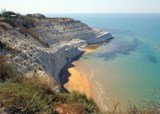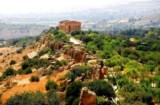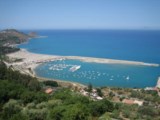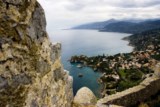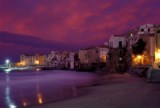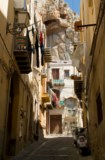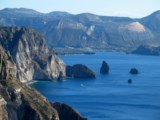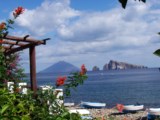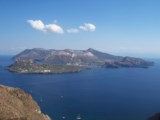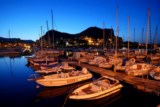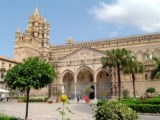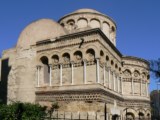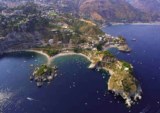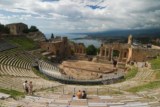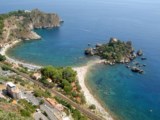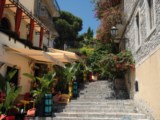Let's travel Together!
Escape to the di.vine
living of sicily south italy
tour south italy - explore south italy - visit south italy
the hot zone of the mediterranean seA
SICILY
 HOTEL ROOMS ACCOMMODATIONS OFFERS IN SICILY STAY BY GEOGRAPHICAL DESTINATION IN COASTAL MOUNTAIN OR RURAL AREA Wine & Food Mount Etna Eolian Islands Pantelleria Lampedusa Ustica
Discover this wonderful island,
home of great historic and romantic sites like Agrigento
and Taormina and only few hours away from other beautiful locations of
Southern Italy like Calabria and it's wonderful rugged coast, Campania and
it's splendid sites like the Amalfi Coast, Sorrento, Capri, or even Apulia and
it's characteristic Trulli Houses. Food & Wine
Other Info
The Nature and Variety of Sicily's cuisine has surely been influenced by it's
history the regions history, in fact the influences from North Africa, Greece and
Spain are evident. Souvenirs & Suggestions Taormina has
many exclusive boutiques, where you can find the top designer labels. A
relaxing walk along the "Corso Umberto" is a must
for the fashion conscious, either just to window shop, or maybe for that
special purchase.
Myth
Sicily was chosen by the gods of the Olympus as the scene of their stories of love and
hatred, of passion and revenge, of sudden wrath and deep compassion.
One day, to free her daughter Proserpine from the insistent courting of Apollo and Mars, Ceres decides to hide her in a safe place: Sicily. But as Proserpine is picking flowers along the banks of Lake Pergusa near
Enna, she is sighted by Pluto, the god of the underworld, who wants her as his
bride. Pluto was a god with rough manners, so he breaks out of the round,
carries away poor Proserpine on a golden chariot pulled by four black horses and disappears into an abyss
that breaks open near the spring of Arethusa.
Only the nymph Cyane hears her cries and rushes to her aid, but will be
punished for doing so. |
||||||||
|
|
||||||||
worlds hot zone in the mediterranean sea
The South of Italy
7 REGIONS from ROME to SICILY
APULIA
Apulia, a land located in the centre of the Mediterranean at the southern extremity of Europe, offers splendid views from commanding positions, over fertile valleys towards the sparkling Adriatic, delicious food and wine and a wonderful warm climate. Here, Nature imposes itself with a wonderful variety of rich colours: red earth, dark green pine, silvery green olive trees and lush vineyards; sparkling white labyrinths of towns which seem to glisten in the sun; milky white medieval centres with tangles of streets and alleyways, all against a backdrop of the deep blue Mediterranean Sea. In this land you will find gems of architectural and historical interest: Romanesque, Byzantine and Baroque churches, cathedrals, castles, towers, prehistorical remains and last but not least the Trulli Houses.
BASILICATA
Basilicata, magical and vague. Land of light and clay, woods and mountains, that can lead to the desire of its discovery without noticing. This is a small region who’s solitary mountains gently fall to the Tyrrhenian Sea on one side and to the Ionian Sea on the other. Basilicata is surrounded by other territories of Southern Italy, like Calabria that leads to Sicily, Campania with it's Amalfi Coast and Sorrento, or Apulia with it's Trulli Houses. Some of it's typical villages lay peacefully on the rocks allowing a silent and reserved stay with great views of it’s rugged coast, others lay next to the beach, surrounded by nature, offering fun and entertainment.
CALABRIA
This is a land with a wonderful coast line; dramatic cliffs overhanging secluded bays; steep cliff paths to small rocky coves; islands and caves to explore; long stretches of beach, gently curving into the distance all are lapped by the clear, azure sea. Calabria makes up the "toe" of Italy and is an area little known to British visitors. The scenery is spectacular and dramatic, rising to over 6000 ft in the mountains, and dropping steeply to the coast with its long stretches of beach, crescent-shaped bays, craggy cliffs and islands dotted about in the crystal clear, blue, Tyrrhenian and Ionian seas. You will be spoilt for choice whether in the mountains or on the coast, there is more to see and explore than can possibly be done in a couple of weeks. On the other hand, the slow southern Italian pace of life is perfect for just relaxing. Calabria is steeped in history, myth and legend. There are prehistoric settlements and early cave dwellings. The region features in the writings of Homer and Virgil and has been fought over by Hannibal, Romans, Sparticans and many others. It is also rich in living tradition and folklore. Throughout the year, there is a wealth of festivals and carnivals, involving much music and dancing, often in traditional costume.
CAMPANIA
This is the land where the deep South of Italy truly begins. Campania is the region that houses wonderful world wide known sceneries like the Amalfi Coast, Sorrento and Capri but is also doorway to other most beautiful locations of Southern Italy like Calabria with it's wonderful rugged coast, Sicily and it's romantic and historic towns like Agrigento and Taormina, and also just few hours away from Apulia and it's characteristic Trulli Houses or Basilicata with beautiful towns like Maratea. Campania features a volcanic sea of the deepest shade of blue lined with miles of dramatic coast and dotted with such lovely islands that almost seem to be tiny, brightly coloured jewels. Sharp contrasts don't miss in this region going from the heat, noise and urban sprawl of troubled Naples to the calming qualities of Sorrento, from the romantic islands of Capri and Ischia to the undiscovered coastline of Cilento. One typicality of Campania will never miss throughout the whole region and that's the warm welcoming as well as the calm qualities of it's people. Enjoy all of Campania's culinary gems, starting from the world known "pizza" that originates from this region of Italy, and created in Honour of the Queen Margherita, going through it's cakes and sweets and ending to it's typical liquors.
MOLISE
The Molise region shared its history with Abruzzo until the fall of the Roman Empire, as evidenced by findings in Pineta of Homo Aeserniensis, who moved between the two regions on a seasonal basis. All the main centres in Molise became Roman colonies with the conquests during the Social War and the Samnite Wars and Second Punic Wars (such as Morrone del Sannio, Isernia, Larino, Venafro and Pietrabbondante), with the formation of new Christian-led urbanisations, such as the Diocese of Trivento, until the Normans arrived. Invasions by the Goths and Lombards followed and, after the latter's conversion to Catholicism, the church gained much power over Molise. A key date in the history of Molise is 1221, when Frederick II, Holy Roman Emperor turned Molise into a district of imperial justice. Several monasteries were founded here, including the splendid site of the Madonna delle Grotte in Rocchetta a Volturno.
SARDINIA
Seaside views in Sardinia are among the most marvellous in the world. Beautiful little isles scattered around its coastline. The coasts are scraggy and rocky, surrounded by shallow sea and astonishing beaches of fine sand and coves. Striking beauty of nature, christal-emerald clear waters of the Mediterranean sea, warm, welcoming people, typical cuisine, old traditions and wonderfull culture, all in one territory, with museums to visit, plenty of activities to take part to, natural environments to explore or beautifull beaches to simply relax on. Sardinia is the second largest island in the Mediterranean, full of culture, history, nature, folklore and entertainment.
SICILY
This wonderful island is the home of great historic and romantic sites like Agrigento and Taormina and only few hours away from other beautiful locations of Southern Italy like Calabria and it's wonderful rugged coast, Campania and it's splendid sites like the Amalfi Coast, Sorrento, Capri, or even Apulia and it's characteristic Trulli Houses. This beautiful island hoststhe Mount Etna, Europe's highest and most active volcano, which looms menacingly over the eastern end of the island. If you are lucky, you could witness the glow of molten lava flowing from fissures in the rock and the most spectacular fireworks display you have ever seen. This is the island that hosts great historical architectural buildings andwhere Africa meets Europe blending Baroque with Classical. Sicily is a land where not only you can sit and enjoy the heat of the sun but also discover and explore its Greek Temples, Baroque churches and any other historical site you can find. No need for great studies to make great discoveries: Sicily will just show them to you, with all their glamour.
the tyrrhenian sea
the worlds hot zone
worlds
from Rome south The South of Italy
MOUNT VESUVIUS VOLCANO
POMPEI ERCOLANO PAESTUM
AMALFI POSITANO COAST
MOUNT ETNA VOLCANO
STROMBOLI VOLCANO
EOLIAN ISLANDS
CAPRI ISLAND
TRULLI LAND
FRIENDLY PEOPLE
HOT ROMANTIC CHARACTER
BREATH TAKING COASTAL VIEWS
BREATH TAKING MOUNTAIN VIEWS
HISTORICAL CHARACTER MONUMENTS
TRADITIONAL OLD CHARACTER ROOKED TOWNS
LOTS OF BEAUTIFUL TIRRHENIAN & IONIAN ISLANDS
LOCAL TRADITIONAL CELLAR WINES TESTING
LOCAL TRADITIONAL FOOD
LOCAL TRADITIONAL CHEFS
LOCAL TRADITIONAL WINES
Paola
signature:
Creator of
new unforgettable memories


